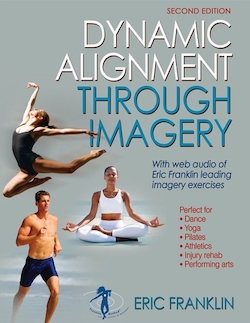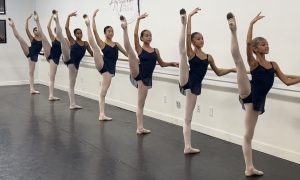You know those “a ha!” moments in your dance training, those exciting moments of embodied understanding? Think back to those for a moment. For me, most of them were connected to imagery of some sort — to something in everyday life, or to seeing in my mind’s eye something in my anatomy moving in a certain way. I’d bet that it’s similar for many dancers out there.
Eric Franklin’s Dynamic Alignment through Imagery takes that sort of process, of learning about movement or dance technique through an image, to a whole other level of knowledge, nuance and action. In fact, Franklin suggests incorporating the exercises in the book into daily movement practice, and the immensity of what the book offers could make that kind of conscious movement practice a lifestyle of its own.

The work begins with explaining the history of alignment through movement, which — fun fact — goes all the way back to Ancient Egypt. It’s intriguing and humbling to learn about people such as Lulu Sweigard and Joan Skinner, movement enthusiasts who became so fascinated with the potential for imagery to guide people toward healthier, more functional movement that they dedicated their lives to studying, practicing and teaching their own methodologies in the form. Other innovators in this area are ones I know well — Joseph Pilates and Bonnie Bainbridge Cohen, for example — yet it’s thought-provoking to think of how their movement forms and philosophies fit into an imagery for dynamic alignment framework.
The intrigue continues through Chapter 2, which breaks down imagery and methodological approaches to safe, functional posture — the root of dynamic alignment. For instance, one approach is to imagine the head resting on the body while another is to imagine the body hanging from the head. It’s fascinating to practice these and notice subtle differences in the body! Following chapters give further basics of imagery for alignment and movement — the why, the how, the what and the where (as in where in the body). For example, just scratching the surface of the complexity of this area of study and practice is how one can imagine the image internally (seeing the movement happening directly in the body as affected by the image) or externally (seeing oneself moving with the influence of the image, as if watching a movie).
Other insights challenged my training and experience as a movement/fitness instructor. For example, “co-contraction” is a common cue in Pilates, meant to stabilize the core through deep abdominal contraction and integration — one I’ve both given and received countless times through teaching and taking Pilates classes. Franklin, however, believes that the level of “stabilizing” that co-contraction creates is actually rigidity, and that’s not functional because it doesn’t allow for the slight adjustments that create dynamic alignment. I believe that questioning preconceptions is intellectually healthy; I’m now inspired to discuss this with other movement/fitness professionals and hear what they think. I’m almost always supportive of creating dialogue, because it leads to learning!
Part II offers an immense amount of knowledge as well — from laws of physics that affect imagery, alignment and movement to breaking down what finding “center” really means (certainly meaningful for dancers!) to the ways muscles and joints work. When I opened this book, I didn’t expect to take deep dives into physics and physiology, but there it is! All of this is accompanied and visualized through delightful drawings — cartoonish in a positive sense: creative, imagistic, memorable and plain fun.
What I found more challenging as the chapters continue was the vast amount of information that Franklin presents, including detailed breaking down of kinesiology nitty-gritty — such as the way the parts of the pelvis widen and narrow with hip flexion and extension (and there are several parts moving in several different directions, something I never knew!). Challenging isn’t necessarily bad; it’s just something to recognize. The beautiful drawings did help me visualize, and from that understand, the information Franklin is giving. Yet even so, particularly in long sections without drawings, it could be a challenge to take it all in — and I have a fairly extensive knowledge of anatomy. I could just imagine someone first learning a lot of the basics here being overwhelmed by it all.

At different degrees, that remained the case through sections breaking down intricate anatomy, kinesiology and images that shape movement and alignment for all regions of the body — pelvis/hips/upper leg, knees/lower leg/feet, spine and abdominal center, shoulders/arms/hands, head and neck, rib cage/breath/organs. Reading the book felt like a deeper dive into anatomy than I’ve ever taken, in a book I expected to be about alignment and imagery.
Concrete information about how the information plays into dance technique or dancer safety did always help understanding, and while I was reading I was wanting more of that. Other dancers laser-focused on their technique and artistry reading this, I’d wager, would feel the same. On the other hand, taking the learning on anatomy and kinesiology sometimes out of the context of dance art could expand dancers’ understanding of its applications and implications — such as in their cross-training and simply how they operate their instrument when not dancing. That’s a healthy and productive thing, I’d argue, because it can lead dancers to a safer, more functional life in their body.
The images from everyday life, such as a geyser flowing from the bottom to the top of the pelvis to encourage spaciousness and lift through the pelvis and lower back, also felt evocative, accessible and memorable to me — and therefore, I’d argue, effective. That leads me back to thinking about expectations and scope. As alluded to, I learned much more in this book than I expected to. Additionally, for it to truly make a difference in my movement, toward greater safety and functionally, I believe that I’d have to 1) read the 400-page book a few times to get a better grasp of the gargantuan amount of information presented, and 2) incorporate the many exercises into my daily movement practice.
I think about the wide scope of what I could add into my daily movement practice from Franklin’s book, from the hundreds of exercises he details. That makes the work of imagery for dynamic alignment seem like a movement practice of its own — beyond that, a way to understand and approach movement and the body itself. Like yoga, dance artistry or fitness, it could become an all-encompassing lifestyle in movement. That’s a powerful and meaningful thing.
On the other hand, for those just wanting a quick guide to this work, I’d love to see a 100-page version of this book that breaks down basic anatomy, physiology and physics involved in it, with some basic exercises to start with. Perhaps Franklin would bristle at the idea; he might say that book would be incomplete and therein maybe even harmful. Regardless, for those picking up Dynamic Alignment through Imagery for the first time, be prepared to take away some meaningful insights.
For more information on Eric Franklin, visit franklinmethod.com.
By Kathryn Boland of Dance Informa.















